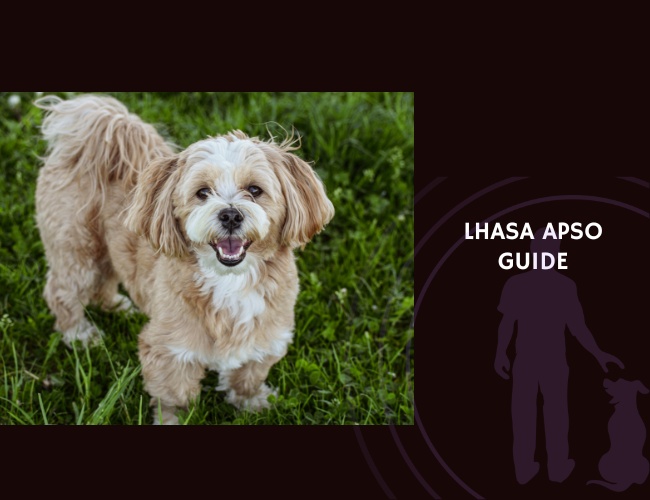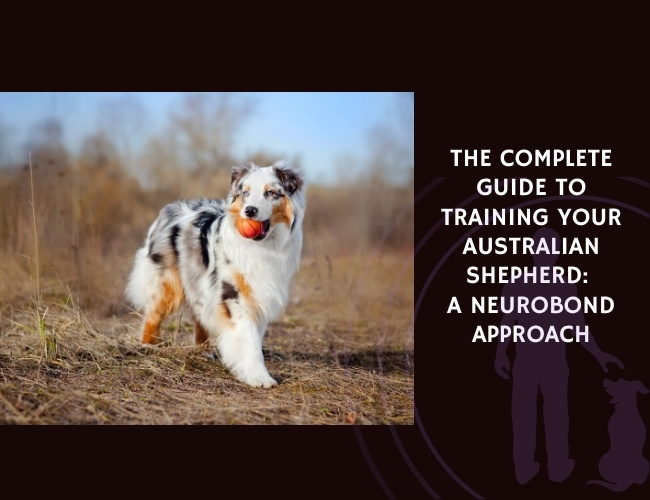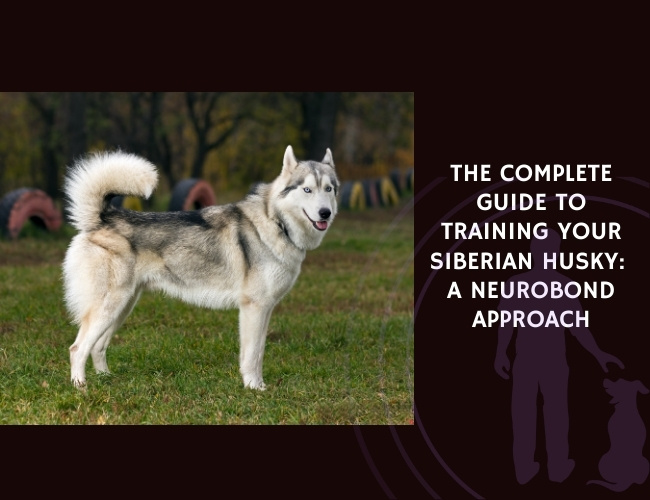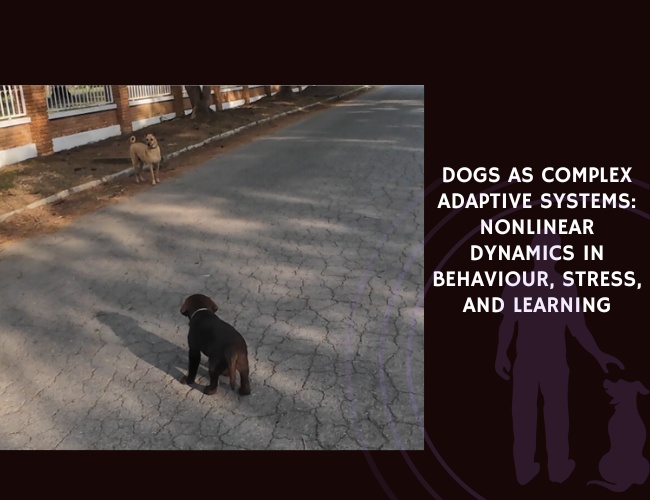Picture a small dog with the heart of a lion, standing sentinel in ancient Tibetan monasteries at altitudes where oxygen runs thin and temperatures plummet—this is the Lhasa Apso, a breed whose millennium-long history as a guardian has shaped every aspect of their remarkable character. These small but robust companions (weighing just 12-18 pounds) combine fierce independence with unwavering loyalty, creating a unique personality that can surprise those expecting a typical lap dog. Let us guide you through understanding this ancient breed, whose distinctive blend of alertness, intelligence, and protective instincts makes them unlike any other small dog you’ll encounter.
Character & Behaviour
Understanding Your Lhasa’s Guardian Heritage
Your Lhasa Apso carries within them over 1,000 years of selective breeding as sentinel dogs in Tibetan monasteries and palaces, working at altitudes exceeding 13,000 feet where survival itself was a challenge. This isn’t just historical trivia—it fundamentally explains why your furry friend might seem aloof with strangers yet devoted to family, or why they’ll sound the alarm at the slightest unusual sound. Did you know that Lhasas worked in tandem with Tibetan Mastiffs, where your little guardian would alert to danger and their larger counterparts would handle the physical threat?
The Core Temperament You’ll Experience: The breed standard describes them as “gay and assertive, but chary of strangers”—and you’ll find this duality defines daily life with your Lhasa. They’re confident leaders of the household, often convinced they’re in charge regardless of their small stature. This isn’t stubbornness for its own sake; it’s the independence bred into them through centuries of making autonomous decisions while guarding sacred spaces. You might notice your Lhasa evaluating your commands before complying, as if asking themselves, “Is this really necessary?” This selective responsiveness reflects their heritage of independent thinking rather than blind obedience.
Living with Their Protective Nature: Your Lhasa’s suspicion of strangers—an attribute prized by Tibetan monks—means you’ll need to manage introductions carefully. They typically remain aloof until determining no threat exists, and this assessment process can’t be rushed. With family members, however, you’ll discover a deeply devoted companion who may show favoritism but extends protective instincts to all household members. This protective nature means they excel as alert dogs, though their size obviously limits their role to notification rather than intervention 🐾
The Independent Mind: Cognitive and Emotional Processing
Understanding how your Lhasa Apso thinks and processes information will transform your relationship with them. Ranking 68th out of 138 breeds in Stanley Coren’s intelligence studies might seem modest, but this reflects their selective cooperation rather than limited cognitive ability. Your Lhasa possesses high problem-solving skills when motivated—the key word being “motivated.”
Memory and Learning Patterns: You’ll quickly discover your Lhasa has an elephant’s memory for people and situations. They’ll remember that visitor who slipped them treats months ago, just as they’ll recall negative experiences with remarkable clarity. This excellent long-term memory serves their guardian role well but means early experiences profoundly shape their adult behavior. They’re quick to learn routines—perhaps too quick, as they’ll anticipate and sometimes attempt to control the household schedule. Their strong spatial memory, evolved for territory guarding, means they’ll notice immediately if furniture is rearranged or new items appear in their domain.
Emotional Intelligence and Sensitivity: Despite their tough exterior, Lhasas possess surprising emotional depth. They’re keenly attuned to household dynamics and can become anxious when routines are disrupted. You might notice your normally confident Lhasa becoming snappish under stress or showing signs of anxiety during changes. This sensitivity requires you to maintain consistency in their environment and daily patterns. Their moderate tolerance for isolation (4-6 hours maximum) combined with their independent nature creates an interesting paradox—they don’t need constant attention but do need to know you’re available.
Vocalization & Communication
Your Lhasa Apso comes equipped with a sophisticated alarm system that would make any security company jealous. Their keen senses and uncanny ability to distinguish friend from foe uniquely qualify them for watchdog duty—but this means you’ll need to understand and manage their vocal tendencies.
Decoding Their Bark Language: Not all Lhasa barks are created equal, and you’ll soon learn to distinguish between:
- The sharp, rapid alert bark announcing someone at the door
- The lower, more sustained warning bark for perceived threats
- The higher-pitched demand bark when they want something
- The excited yip during play or when greeting favorite people
This vocal communication increases dramatically with inadequate mental stimulation. A bored Lhasa is a barking Lhasa, and they may develop excessive barking habits if their intelligent minds aren’t properly engaged. You’ll find that understanding the motivation behind each bark helps you respond appropriately—sometimes acknowledgment is all they need to settle.
Managing the Watchdog Within: Your Lhasa’s barking isn’t a flaw to eliminate but a trait to channel appropriately. They’re hardwired to alert you to anything unusual, from the mail carrier to a leaf blowing past the window. This vigilance, while sometimes exhausting, is exactly what Tibetan monks valued for centuries. The key is teaching them when their job is done—a simple “thank you” or “I’ve got it” command can help them understand their alert has been received and they can stand down 🧡
Training & Education
Early Socialization: The Foundation of Success
The critical socialization period between 3-14 weeks will shape your Lhasa’s entire future, and missing this window can result in a dog who struggles with new experiences throughout life. During these crucial weeks, your puppy’s brain is remarkably plastic, forming neural pathways that determine how they’ll respond to the world.
Creating Positive First Impressions: Begin socialization as early as 3 weeks if you’re working with a breeder, but most importantly, maximize the 8-14 week period when your puppy comes home. Your Lhasa needs exposure to:
- Diverse people of all ages, ethnicities, and appearances (remember, monks in robes were their historical norm!)
- Other dogs and animals, with careful supervision
- Various surfaces—grass, gravel, tile, carpet, metal grates
- Handling for grooming (critical given their coat requirements)
- Common household sounds—vacuum cleaners, doorbells, television
Each experience should be positive but not overwhelming. Your Lhasa’s natural wariness means negative experiences during this period can create lasting fears. Use high-value treats like small pieces of chicken to create positive associations, and always let your puppy approach new things at their own pace.
Addressing Stranger Wariness: Your Lhasa’s inherent suspicion of strangers requires special attention during socialization. Rather than forcing interactions, create positive associations from a distance. Have strangers toss treats without making eye contact or attempting to pet. This teaches your puppy that strangers predict good things without overwhelming their natural reserve. As comfort grows, gradually decrease distance and increase interaction, but always respect your Lhasa’s comfort level.
Obedience and Boundary Setting: Working With, Not Against, Their Nature
Training a Lhasa Apso requires understanding that you’re working with a dog who very much likes things to be their own idea. This isn’t defiance—it’s the independence that allowed them to make autonomous decisions while guarding monasteries. Your approach must respect this while still establishing necessary boundaries.
The Positive Reinforcement Imperative: Harsh discipline will not only fail with your Lhasa but may create lasting resentment. These dogs have long memories and will remember negative training experiences, potentially damaging your relationship permanently. Instead, focus on making compliance rewarding and, whenever possible, making it seem like their idea. Use enthusiastic praise, high-value treats, and play as rewards. When your Lhasa does something right, celebrate it like they’ve just won the lottery—this enthusiasm helps overcome their natural independence.
Managing the Stubborn Streak: You’ll quickly learn that if something isn’t your Lhasa’s idea, they probably won’t be interested. This means traditional command-response training often falls flat. Instead:
- Keep training sessions short (10-15 minutes maximum) to maintain focus
- Use variety to prevent boredom—practice different commands in different locations
- Make training feel like a game rather than work
- End on a positive note, even if progress was minimal
- Be prepared for late emotional maturity—your Lhasa may not fully mature until age 3
Establishing Household Rules: Despite their small size, Lhasas absolutely need clear boundaries. Their tendency to see themselves as pack leaders means without structure, they’ll create their own rules—usually ones you won’t appreciate. Consistency is crucial; ensure everyone in the household uses the same commands and enforces the same rules. Mixed messages confuse your intelligent Lhasa and encourage them to make their own decisions.

Impulse and Bark Control: Channeling Their Guardian Instincts
Your Lhasa’s barking and territorial behaviors aren’t problems to solve but instincts to manage. These behaviors kept monasteries safe for centuries, and attempting to eliminate them entirely goes against your dog’s fundamental nature.
The Bark Management Protocol: Start by identifying your Lhasa’s specific triggers—doorbell, strangers passing, other dogs, or even specific sounds from the TV. Once you understand what sets them off, you can begin desensitization:
- Start with the trigger at very low intensity (doorbell recording at low volume)
- Reward calm behavior before barking starts
- Gradually increase intensity over weeks, not days
- Teach a “quiet” command using positive interruption and rewards
- Provide alternative behaviors—teach them to grab a toy when excited instead of barking
Environmental management plays a huge role. Visual barriers like window films at your Lhasa’s eye level can reduce triggers. White noise or calming music can mask outside sounds that prompt barking.
Territorial Behavior Management: Your Lhasa views your home as their monastery to protect, and this territorial instinct needs thoughtful management:
- Create controlled greeting rituals for visitors—have your Lhasa sit and wait while guests enter
- Establish “safe spaces” where your Lhasa can retreat when overwhelmed
- Set consistent boundaries about furniture and room access
- Build positive associations with strangers through treat-tossing games
- Never punish growling—it’s communication, and removing it creates a dog who bites without warning
Enrichment and Engagement: Satisfying Their Intelligent Minds
Mental stimulation is absolutely crucial for your Lhasa’s wellbeing. Their intelligent minds, evolved for vigilant watching and decision-making, need appropriate outlets or they’ll create their own entertainment—usually involving excessive barking or destructive behaviors.
Mental Stimulation Activities: Your Lhasa’s intelligence shines when properly engaged. Puzzle feeders transform mealtime into mental exercise, while treat-dispensing toys provide independent entertainment. Hide treats around the house for scent work—this taps into their natural investigative instincts. Play hide-and-seek with favorite toys, teaching them toy names and asking them to find specific ones. Interactive training games that require problem-solving keep their minds sharp while strengthening your bond.
Physical Enrichment That Suits Their Size: While not high-energy dogs, Lhasas benefit from varied physical activities:
- Indoor agility courses scaled for small dogs build confidence
- Different walking routes provide mental stimulation through new smells and sights
- Supervised play sessions with compatible dogs offer socialization
- Fetch games adapted for small spaces satisfy their playful side
- Swimming, if introduced early, provides excellent low-impact exercise
Remember, your Lhasa’s exercise needs are moderate—quality matters more than quantity. A mentally stimulating 20-minute walk trumps an hour of mindless leash walking.
Nutritional Recommendations
Balanced Small-Breed Diet: Fueling Your Guardian
Your Lhasa Apso’s nutritional needs reflect both their small size and their surprisingly robust constitution. These dogs, evolved in harsh Tibetan conditions, are generally good eaters but require specific nutritional support for their unique health challenges.
Macronutrient Distribution for Optimal Health: Your Lhasa thrives on a diet with 25-30% high-quality animal protein—this supports their luxurious coat and maintains lean muscle mass despite their small frame. Fat content should range from 15-20%, providing essential energy and supporting coat health. Complex carbohydrates making up 30-40% of the diet offer sustained energy without blood sugar spikes. Don’t forget fiber (3-5%)—it’s crucial for digestive health and helps prevent anal gland issues common in small breeds.
Caloric Requirements Throughout Life: Adult Lhasas typically need 30-40 calories per pound of body weight, translating to about 3/4 to 1 cup of high-quality dry food daily, divided into two meals. Puppies require significantly more—50-60 calories per pound—to support their growth, while seniors often do well on 25-30 calories per pound to prevent weight gain as metabolism slows. You’ll need to adjust these amounts based on your individual dog’s activity level and metabolism; some Lhasas are easy keepers who gain weight readily, while others maintain their weight effortlessly.
Joint and Mobility Support: Preventing Problems Before They Start
Despite their small size, Lhasas are susceptible to several orthopedic issues that make joint support crucial from puppyhood through their senior years. Your proactive approach to joint health can mean the difference between a mobile senior dog and one struggling with mobility.
Essential Joint-Supporting Nutrients: Omega-3 fatty acids from fish oil serve as natural anti-inflammatories, reducing joint inflammation before it becomes problematic. Adult Lhasas benefit from 250-500mg of glucosamine daily, paired with 200-400mg of chondroitin. MSM (50-100mg daily) provides additional anti-inflammatory support, while vitamin C supports collagen synthesis essential for healthy joint structures. These supplements become even more critical if your Lhasa shows early signs of patellar luxation, which affects 7% of small breed puppies.
Weight Management for Joint Protection: Maintaining lean body weight is perhaps the single most important factor in joint health. Every extra pound on your 15-pound Lhasa is equivalent to 7-8 pounds on a human—imagine carrying a bowling ball everywhere! Fresh foods containing natural anti-inflammatories like turmeric and green-lipped mussel can provide additional support. Remember, it’s far easier to prevent joint problems through proper nutrition than to manage them once they develop.
Loyal. Watchful. Unyielding.
Ancient guardians endure. The Lhasa Apso’s centuries as a sentinel in Tibetan monasteries forged a spirit that balances independence with loyalty. Their heritage explains their aloofness toward strangers and their fierce devotion to family, shaping them into protectors despite their small frame.
Selective minds decide. Obedience is never blind with a Lhasa—they weigh commands with quiet scrutiny before responding. This independence isn’t defiance but the result of generations trained to think autonomously while safeguarding sacred spaces. Their confidence often places them at the center of the household.
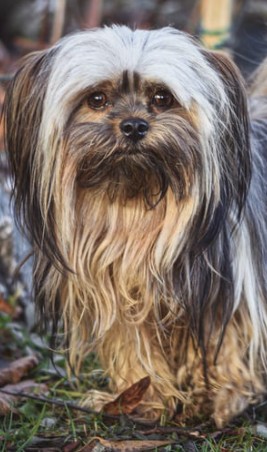
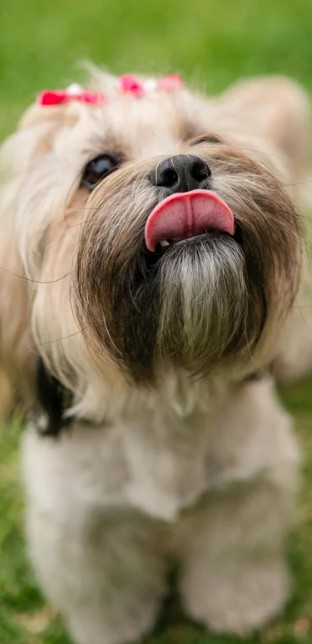
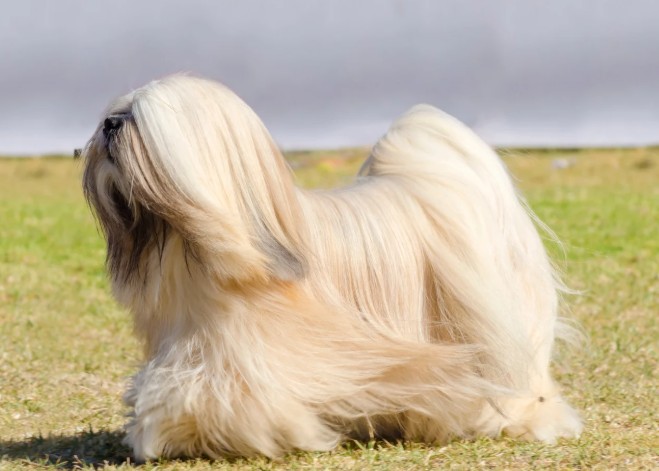
Emotions run deep. Beneath their boldness lies a surprising sensitivity to routine and environment. They remember both kindness and harm with remarkable clarity, requiring stability and patient guidance. With family, their emotional bond reveals a depth that transforms them from watchful guardians into steadfast companions.
Coat and Skin Nutrition: Supporting Their Crowning Glory
Your Lhasa’s spectacular double coat—one of their defining features—requires specific nutritional support to maintain its health and appearance. This isn’t just about aesthetics; a healthy coat protects your dog from temperature extremes and skin issues.
Key Nutrients for Coat Excellence: The foundation of coat health starts with high-quality protein (minimum 25% dry matter), as hair is primarily made of protein. Omega-6 fatty acids from sources like flaxseed and poultry fats create that enviable shine and support skin barrier function. Your Lhasa needs 2.5-5mg of biotin daily for coat growth, along with adequate zinc (120mg per kg of diet) for skin healing and hair follicle health. Vitamin E at 50 IU per kg body weight provides antioxidant protection for skin cells.
Addressing the Omega Fatty Acid Crisis: Here’s something crucial most Lhasa owners don’t realize: commercial dog food processing destroys biologically available fatty acids. Even premium foods lose these essential nutrients during manufacturing. This means omega-3-6-9 supplementation isn’t optional—it’s essential for your Lhasa’s coat and skin health. The ideal omega-6 to omega-3 ratio ranges from 5:1 to 10:1. Without proper supplementation, you might notice dry, flaky skin, excessive shedding, or that characteristic “doggy odor” that suggests sebaceous gland dysfunction.
Digestive Health: Managing Sensitivities
Many Lhasas have sensitive digestive systems, possibly due to centuries of consistent diet in Tibetan monasteries. Understanding and managing these sensitivities ensures your dog maintains optimal health and comfort.
Common Dietary Triggers: Grains, particularly corn and wheat, are frequent allergens for Lhasas. Some individuals also react poorly to chicken—surprising given it’s such a common protein source. Dairy products can cause digestive upset, and artificial additives and preservatives may trigger both digestive and skin issues. If your Lhasa experiences chronic ear infections, excessive paw licking, or recurrent digestive upset, food sensitivities might be the culprit.
Supporting Digestive Balance: Probiotics help maintain healthy gut microbiome balance, especially important after antibiotic treatment or during stress. Prebiotics (FOS, MOS) feed beneficial bacteria, supporting overall digestive health. For sensitive Lhasas, limited ingredient diets help identify and eliminate triggers. Consider novel protein sources like duck, venison, or fish if common proteins cause issues. Remember, dietary changes should be gradual—sudden switches can cause digestive upset even with better food.
Life Stage Nutritional Adjustments
Your Lhasa’s nutritional needs evolve throughout their potentially 15-20 year lifespan, and adjusting their diet accordingly supports healthy aging.
Puppy Power (0-12 months): Growing Lhasas need higher protein (28-32%) to support rapid development. DHA is crucial for brain development—look for foods with added fish oil. The calcium to phosphorus ratio should be 1.2:1 for proper bone development. Feed 3-4 meals daily until 6 months, then transition to twice-daily feeding. Avoid overfeeding during growth—fat puppies don’t become healthier adults, they develop orthopedic problems.
Adult Maintenance (1-7 years): Adult Lhasas do well on moderate protein (22-26%) with focus on maintaining ideal weight. This is when joint support supplements become preventive medicine. Two meals daily prevents bloat and maintains stable blood sugar. Monitor weight carefully—middle age is when many Lhasas start gaining.
Senior Support (7+ years): Senior Lhasas benefit from moderate protein (20-25%) to maintain muscle while protecting kidney function. Enhanced antioxidants combat age-related oxidative stress. Increased fiber aids digestion and prevents constipation. Joint and cognitive support become crucial—omega-3 fatty acids support skin, coat, kidneys, joints, heart, and brain function. Consider adding supplements for cognitive function as your Lhasa ages 🧡
Health Concerns & Disease Prevention
Ocular Disorders: Protecting Their Expressive Eyes
Your Lhasa’s prominent, expressive eyes—while endearing—make them particularly vulnerable to various ocular conditions. Understanding these risks and recognizing early symptoms can preserve your dog’s vision and comfort throughout their life.
Progressive Retinal Atrophy (PRA): This genetic condition causes gradual vision loss, initially affecting night vision before progressing to complete blindness. You might first notice your Lhasa hesitating to go outside at dusk or bumping into furniture in dim light. While no treatment exists, genetic testing (PRA1 and PRA4) can identify carriers before breeding. If your Lhasa develops PRA, they can adapt remarkably well to blindness in familiar environments—keep furniture placement consistent and use verbal cues to help them navigate.
Keratoconjunctivitis Sicca (Dry Eye): Affecting 20-30% of the breed, dry eye occurs when tear production fails to keep eyes adequately lubricated. You’ll notice thick, pus-like discharge, frequent blinking, and your Lhasa pawing at their eyes. This condition requires lifelong daily medication—typically cyclosporine drops—but responds well to treatment when caught early. Missing medications even for a few days can lead to corneal ulcers and permanent damage, so consistency is crucial.
Managing Age-Related Cataracts: As proteins in the lens break down with age, cataracts cloud your senior Lhasa’s vision. Unlike PRA, cataracts are treatable through surgery with excellent success rates. You’ll notice a bluish or white appearance in the eye’s center, and your dog might struggle with depth perception or become hesitant on stairs. Early intervention offers the best outcomes, so regular veterinary eye exams after age 7 are essential.
Orthopedic Challenges: Small Dog, Big Problems
Despite their small stature, Lhasas face several orthopedic challenges that can significantly impact quality of life without proper management.
Patellar Luxation: The Slipping Kneecap: This condition, where the kneecap slips out of its groove, affects many Lhasas to varying degrees. Grade I luxation might cause occasional skipping, while Grade IV results in permanent dislocation and lameness. You might notice your Lhasa suddenly lifting a back leg while running, then returning to normal—this “skipping” is classic luxation. While Grades I-II often manage well with weight control and supplements, Grades III-IV typically require surgical correction. Early intervention prevents arthritis development in the affected joint.
Hip Dysplasia in Small Packages: Though more common in large breeds, hip dysplasia can affect Lhasas, causing pain and mobility loss. Signs include bunny-hopping gait, difficulty rising, and reluctance to climb stairs or jump. Management combines weight control, joint supplements, and pain management. In severe cases, surgical options exist, though many Lhasas respond well to conservative management given their light weight.
Intervertebral Disc Disease (IVDD): Your Lhasa’s relatively long back predisposes them to spinal problems. Prevention is key—maintain ideal weight to reduce spinal stress, use ramps instead of allowing jumping from furniture, and support their back when lifting. Warning signs include reluctance to move, crying when touched, and dragging limbs. IVDD is a medical emergency requiring immediate veterinary attention; early intervention dramatically improves outcomes.
Respiratory and Brachycephalic Considerations
While not as extreme as some flat-faced breeds, your Lhasa’s shortened muzzle creates some respiratory considerations requiring careful management.
Understanding Brachycephalic Airway Syndrome: The severity varies among individuals, but many Lhasas experience some degree of breathing difficulty due to their facial structure. You might notice snoring, noisy breathing, or exercise intolerance. Hot, humid weather poses particular risks—your Lhasa can’t cool themselves as efficiently as longer-nosed breeds. Keep indoor environments cool, avoid midday summer exercise, and never leave your Lhasa in a car, even briefly.
Exercise and Heat Management: Monitor your Lhasa carefully during exercise for signs of respiratory distress—excessive panting, blue-tinged gums, or collapse require immediate cooling and veterinary attention. Swimming provides excellent exercise without respiratory stress, though not all Lhasas take to water naturally. Indoor play during summer heat keeps your dog active without risk. Consider a cooling vest for necessary outdoor summer activities.
Dermatological Issues: More Than Skin Deep
Skin problems can significantly impact your Lhasa’s quality of life, and their thick double coat can hide issues until they’re advanced.
Sebaceous Adenitis: The Hereditary Challenge: This inherited condition destroys sebaceous glands, causing dry, flaky skin, hair loss, and a distinctive musty odor. Symptoms range from mild scaling to severe hair loss with secondary infections. While incurable, management through frequent medicated baths, oil treatments, and supplements can control symptoms. Regular grooming helps identify problems early—your groomer might notice changes before they’re visible through the coat.
Managing Allergic Dermatitis: Environmental and food allergies commonly affect Lhasas, causing intense itching, redness, and secondary infections from scratching. Identifying triggers requires patience—elimination diets for food allergies, intradermal testing for environmental allergens. Management might include antihistamines, immunotherapy, or newer medications like Apoquel or Cytopoint. Regular bathing with hypoallergenic shampoos removes allergens from the coat and soothes irritated skin.

Genetic Health and Longevity Factors
Your Lhasa Apso belongs to one of the longer-lived breeds, with proper care supporting lifespans extending well into the late teens or even early twenties.
Understanding Their Longevity Advantage: A 2024 UK study found Lhasa Apsos averaging 14 years compared to 12.7 for purebreds overall. This longevity stems from their ancient breed status—thousands of years of natural selection in harsh conditions created a tough genetic foundation. Their relatively low genetic diversity within the breed is offset by strong selection for hardiness over generations.
Essential Health Screenings: Responsible breeding requires PRA genetic testing, patellar evaluation, and hip scoring. If acquiring a puppy, request proof of parent testing. For your adult Lhasa, annual eye exams catch problems early, while regular orthopedic evaluations identify developing issues. Blood work every 6-12 months after age 7 catches organ dysfunction early, when intervention is most effective.
Other Health Considerations: Renal dysplasia (kidney malformation) can affect young Lhasas—watch for excessive thirst and urination. Von Willebrand’s disease, a bleeding disorder, requires testing before surgery. Bladder stones are relatively common—encourage water intake and monitor urination patterns. Portosystemic shunt, where blood bypasses the liver, causes stunted growth and neurological signs in puppies 🐾
Lifestyle & Environment
Exercise Needs: Quality Over Quantity
Your Lhasa Apso’s exercise requirements reflect their unique blend of watchdog alertness and companion dog contentment. Unlike high-energy breeds that need hours of activity, your Lhasa thrives on moderate, purposeful exercise that engages both body and mind.
Daily Exercise Framework: Adult Lhasas need approximately 40 minutes of daily physical activity, but this doesn’t mean one long walk. Split exercise into two 20-minute sessions to maintain interest and prevent overexertion. Morning walks when the world is waking up provide mental stimulation through new scents and sounds, while evening strolls help establish bedtime routines. Remember, your Lhasa’s short legs mean they’re taking three steps for every one of yours—what seems like a leisurely stroll to you is genuine exercise for them.
Tailoring Exercise to Life Stages: Puppies need carefully managed activity—the old rule of “five minutes per month of age” protects developing joints. Short, frequent play sessions throughout the day suit their attention spans and energy bursts. Adult Lhasas enjoy varied activities: fetch games that tap into their playful nature, nose work that engages their intelligence, and social walks where they can practice their guardian watching. Senior Lhasas benefit from gentle, consistent exercise—swimming provides excellent low-impact activity if they’re comfortable in water, while shorter, more frequent walks maintain mobility without causing fatigue.
Adaptability to Different Environments
One of your Lhasa’s greatest strengths is their remarkable adaptability to various living situations—from studio apartments to country estates, these versatile dogs adjust to their environment with surprising ease.
Apartment Living Excellence: Lhasas are exceptionally well-suited for apartment life, and not just because of their small size. They’re generally content living indoors and don’t require a yard to burn off excess energy. Their moderate exercise needs are easily met with indoor play and regular walks. The main consideration? Their barking might disturb neighbors, making early training essential. You’ll find that acknowledging their alerts (“Thank you for telling me”) often satisfies their need to warn you, reducing prolonged barking episodes.
Urban Versus Rural Considerations: In urban environments, your Lhasa benefits from the socialization opportunities cities provide—regular encounters with diverse people, dogs, and situations keep their minds engaged. The controlled nature of city walks suits their moderate exercise needs perfectly. In rural settings, they enjoy secure outdoor spaces but still prefer being where you are. Their ancient guardian instincts mean they’ll patrol property boundaries with serious intent, regardless of their small size. Whether city or country, your Lhasa adapts to your lifestyle rather than demanding you adapt to theirs.
Space Requirements Reality: Don’t let anyone tell you Lhasas need lots of space—they need lots of engagement. A studio apartment with an attentive owner beats a mansion with an absent one. Mental stimulation matters far more than square footage. Your Lhasa will be equally happy in 500 or 5,000 square feet, as long as they have their person, their routine, and their purposeful activities.
Climate Resilience: From Tibetan Peaks to Modern Homes
Your Lhasa’s Tibetan heritage, evolved at 13,000 feet with 40% less oxygen than sea level, created remarkable climate adaptability that serves them well in various conditions.
Cold Weather Champions: That luxurious double coat isn’t just for show—it’s sophisticated insulation technology. The soft undercoat traps warm air while the longer guard hairs repel moisture and wind. Your Lhasa will often seek out cold surfaces in winter, comfortable at temperatures that send other small dogs shivering. Snow doesn’t deter them; many Lhasas delight in plowing through drifts that reach their chests. However, ice-melt chemicals can burn paw pads, so consider booties or paw wax during winter walks.
Heat Management Strategies: Despite their cold-weather prowess, Lhasas need careful management in heat. Their brachycephalic features, while not extreme, do impact cooling efficiency. During summer, schedule exercise for early morning or evening when temperatures drop. Air conditioning isn’t luxury—it’s necessity during heat waves. Many owners opt for summer “puppy cuts” to help their Lhasas stay cool, though this removes their natural insulation and sun protection. If you keep the coat long, ensure it’s well-maintained—matted fur traps heat and prevents air circulation.
Family and Social Dynamics
Understanding how your Lhasa interacts with different family members and other pets helps create household harmony while respecting their unique social needs.
Children and Your Lhasa: Lhasas can thrive with children, but success depends on mutual respect and proper introductions. They’re best suited for families with older, calmer children who understand boundaries. Your Lhasa won’t tolerate tail-pulling, rough handling, or being treated like a toy. Teach children to respect your dog’s space, especially during meals or rest. Supervision remains essential—even the most patient Lhasa has limits, and their warning signs might be subtle. When raised with respectful children, Lhasas often become devoted guardians, following “their” kids everywhere and alerting to any perceived dangers.
Multi-Pet Household Dynamics: Your Lhasa’s conviction that they’re large and in charge creates interesting dynamics in multi-pet homes. Size is irrelevant to them—they’ll cheerfully boss around dogs ten times their weight. Early socialization helps, but even well-socialized Lhasas often prefer being alpha. Same-sex aggression can occur, particularly between intact males. Success comes from establishing clear pack hierarchy with you firmly at the top. Introduce new pets gradually and in neutral territory. Many Lhasas coexist peacefully with cats, though their movement might trigger chase instincts without proper training.
The Senior Companion Connection: Lhasas make exceptional companions for older adults, and here’s why: their moderate exercise needs match senior activity levels perfectly. Their size makes them manageable even for those with limited strength or mobility. Their watchdog nature provides security without the management challenges of larger guard breeds. The grooming routine offers purposeful daily activity and bonding time. Many seniors find the Lhasa’s independent yet affectionate nature ideal—they’re loving without being overwhelmingly needy 🧡
Creating the Ideal Living Environment
Setting up your home to accommodate your Lhasa’s needs ensures everyone’s comfort and happiness.
Essential Environmental Modifications: Create defined spaces that respect your Lhasa’s guardian instincts. A comfortable perch near windows lets them survey their domain—many Lhasas spend hours watching the world. Baby gates help manage territory without isolation. Raised feeders can help prevent neck strain during meals, though they’re not essential. Non-slip rugs on smooth floors prevent injuries, especially important for seniors or dogs with luxating patellas.
The Grooming Station: Given daily brushing requirements, establish a dedicated grooming area. A non-slip table at comfortable height saves your back and makes grooming easier. Keep supplies organized and accessible—slicker brush, metal comb, detangling spray, and treats for cooperation. Good lighting helps spot mats before they become problems. Many owners find that making grooming a predictable routine reduces resistance.
Safe Spaces and Retreat Options: Every Lhasa needs a private retreat where they won’t be disturbed. This might be a crate with the door removed, a bed in a quiet corner, or a designated room. Teach family members to respect this space absolutely—when your Lhasa retreats there, they’re communicating need for solitude. This prevents defensive snapping and gives your dog control over social interactions.
Senior Care & Aging Gracefully
Adapting Care for the Golden Years
Your Lhasa’s potential for exceptional longevity—often reaching 15-17 years with many living into their early twenties—means planning for extended senior care. The transition to senior status happens gradually, typically around age 8-10, though many Lhasas maintain youthful attitudes well into their teens.
Recognizing Age-Related Changes: You might first notice your senior Lhasa taking longer to rise in the mornings or hesitating before jumping onto favorite furniture. Their once-eager response to the leash might become more measured. These aren’t signs of stubbornness but natural aging. Vision changes often manifest as hesitancy in dim light or bumping into relocated furniture. Hearing loss might make them seem disobedient when they’re simply not hearing commands. Cognitive changes can include confusion, altered sleep patterns, or forgetting house training. Recognizing these as medical rather than behavioral issues ensures appropriate response.
Exercise and Mobility Modifications: Senior Lhasas benefit from consistent, gentle exercise rather than sporadic intense activity. Shorter, more frequent walks maintain muscle tone without causing exhaustion. Swimming, if your Lhasa enjoys it, provides excellent low-impact exercise. Ramps to furniture and cars prevent jarring jumps that stress aging joints. Mental exercise becomes even more crucial as physical activity decreases—Mental changes can be subtle. Your senior Lhasa might become more set in their ways, less tolerant of disruption, or occasionally confused about familiar routines. Cognitive dysfunction syndrome, similar to human dementia, affects some older dogs. Keeping their mind active through gentle training, puzzle toys, and maintained routines helps preserve cognitive function.
Comfort Modifications for Senior Living
Simple adjustments can significantly improve your aging Lhasa’s quality of life. Orthopedic beds provide joint support, while raised food bowls reduce neck strain. Non-slip rugs prevent falls on slippery floors, and night lights help dogs with declining vision navigate safely.
Consider these senior-friendly modifications:
- Ramps to favorite furniture spots
- More frequent, shorter walks
- Heated beds for arthritic joints
- Regular massage to maintain circulation
- Supplements for joint and cognitive support
Your senior Lhasa might need more frequent veterinary checkups – twice yearly rather than annually. Blood work can catch problems early when they’re most treatable. Don’t dismiss changes as “just old age” – many conditions affecting senior dogs are manageable with proper treatment.
Making the Decision: Is a Lhasa Apso Right for You?
The Reality Check: Honest Considerations
Before bringing a Lhasa Apso into your life, let’s have an honest conversation about what these dogs really need. Yes, they’re small and adaptable, but they’re not low-maintenance lap dogs. That independent streak that makes them so interesting also means they’re not eager-to-please Golden Retrievers. Can you appreciate a dog who thinks before obeying?
The grooming commitment is real and non-negotiable. Even with a puppy cut, you’re looking at daily brushing and professional grooming every two months. Those flowing locks don’t maintain themselves, and neglected coats quickly become painful mats.
The Rewards: Why Lhasa Owners Are Devoted
Here’s what makes all the challenges worthwhile: Lhasa Apsos offer a depth of companionship that’s hard to find elsewhere. Their loyalty isn’t blind devotion – it’s a conscious choice to bond with you, making it incredibly meaningful. When your Lhasa curls up against you after a long day, you know you’ve earned that affection.
These dogs bring centuries of wisdom wrapped in a small, manageable package. They’re equally happy in a studio apartment or sprawling estate, asking only for your companionship and respect for their unique nature. Their longevity means you’re likely to share 15+ years together – a significant portion of your life enriched by their presence.
Finding Your Perfect Lhasa Companion
If you’ve decided a Lhasa Apso is right for you, finding the right individual dog is crucial. Reputable breeders conduct health testing for PRA, patellar luxation, and hip dysplasia. They’ll welcome questions about their breeding program and want to know about your lifestyle to ensure a good match.
Consider these sources:
- Breed-specific rescues: Adult Lhasas in rescue often come with known temperaments
- Reputable breeders: Look for those involved in showing or performance events
- Avoid: Pet stores, online brokers, or anyone who won’t let you meet the parents
When meeting potential puppies or adult dogs, look for confident but not aggressive behavior. A well-socialized Lhasa might be reserved with you initially but shouldn’t cower or show excessive fear. Trust your instincts – the right dog often chooses you as much as you choose them.
Conclusion: Your Journey with an Ancient Companion
As we reach the end of our comprehensive guide, you now understand that the Lhasa Apso is far more than just a pretty face with flowing locks. These remarkable dogs carry within them the echoes of Tibetan monasteries, the wisdom of ancient breeding, and the heart of a lion wrapped in a small, lovable package. They’re not the right choice for everyone – and that’s perfectly okay.
The Lhasa Apso asks you to earn their trust, respect their independence, and appreciate their unique perspective on the world. In return, they offer unwavering loyalty, surprising toughness, and a depth of personality that continues to reveal itself throughout your years together. Their guardian instincts mean you’ll always have a devoted protector, while their size makes them practical companions for modern living.
Success with a Lhasa Apso comes from understanding and working with their nature rather than against it. Embrace their independence as intelligence, channel their guardian instincts appropriately, and maintain their health through proper nutrition and preventive care. The grooming commitment, training challenges, and health considerations are real – but so are the rewards of sharing your life with these extraordinary dogs.
Whether you’re drawn to their ancient heritage, captivated by their unique personality, or simply looking for a small dog with a big heart, the Lhasa Apso offers something special. They’re living history, loyal companions, and constant reminders that the best things in life often come in small, slightly stubborn, absolutely adorable packages. Welcome to the wonderful world of Lhasa Apso ownership – may your journey together be filled with love, laughter, and just the right amount of independent spirit. 🐾

